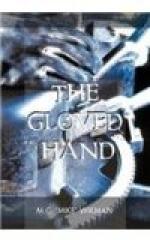He compared them one by one, in the same manner. When he had finished, there was no escaping the conviction that they had been made by the same hand—that is, unless one denied the theory of finger-print identification altogether, and that, I knew, would be absurd. As he finished his demonstration, Sylvester glanced over my shoulder with a little deprecating smile, as of a man apologising for doing an unpleasant duty, and I turned to find Swain standing there, his face lined with perplexity.
“You heard?” I asked.
“Yes; and I believe Mr. Sylvester is right. I can’t understand it.”
“Well,” I said, “suppose we go and have some lunch, and then we can talk it over,” and thanking Sylvester for his courtesy, I led Swain away. Godfrey fell into step beside us, and for some moments we walked on in silence.
“There is only one explanation that I can see,” said Godfrey, at last. “Swain, you remember, got to the library about a minute ahead of us, and when we reached the door he was lifting Miss Vaughan to the couch. In that minute, he must have touched the dead man.”
Swain shook his head doubtfully.
“I don’t see why I should have done that,” he said.
“It isn’t a question of why you did it,” Godfrey pointed out. “It’s a question of whether you did it. Go over the scene in your mind, recalling as many details as you can, and then we’ll go over it together, step by step, after lunch.”
It was a silent meal, and when it was over, Godfrey led the way into his study.
“Now,” he began, when we were seated, “where was Miss Vaughan at the moment you sprang through the door?”
“She was lying on the floor by the table, in front of her father’s chair,” Swain replied.
“You are sure of that?”
“Yes; I didn’t see her until I ran around the table.”
“I was hoping,” said Godfrey, “that she had fainted with her arms clasped about her father’s neck, and that, in freeing them, you made those marks on his robe.”
But Swain shook his head.
“No,” he said; “I’m positive I didn’t touch him.”
“Then how did the marks get there?”
“I don’t know,” said Swain helplessly.
“Now, see here, Swain,” said Godfrey, a little sternly, “there is only one way in which those finger-prints could have got on that garment, and that is from your fingers. If you didn’t put them there consciously, you must have done so unconsciously. If they aren’t explained in some way, the jury will very probably hold you responsible for the crime.”
“I understand that,” Swain answered thickly; “but how can they be explained? I don’t see why I should put my hands on Mr. Vaughan’s throat, even unconsciously. And then there’s the fact that at no time during the evening was I really unconscious—I was only confused and dazed.”
“Goldberger’s theory is plain enough,” said Godfrey, turning to me; “and I must say that it’s a good one. He realises that there wasn’t provocation enough to cause a man like Swain to commit murder, with all his senses about him; but his presumption is that the crime was committed while Swain was in a dazed condition and not wholly self-controlled. Such a thing is possible.”




